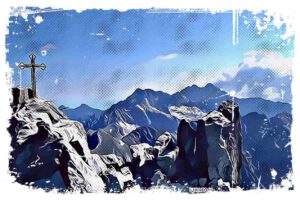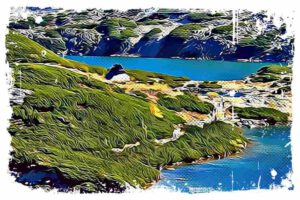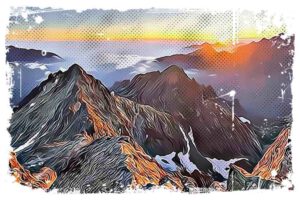Camping outside of designated shelters in Tatra National Park remains forbidden, and it’s likely to stay that way for a long time. Sure, there are 8 operating shelters in Poland, but prices and availability can vary greatly between them.
Every Tatra enthusiast must have dreamt of a safe and cozy camping experience right in the heart of the Tatra Mountains. Who wouldn’t want to pitch their tent near Kościelec or Zadni Staw Polski? I can already imagine sipping hot coffee in the morning as the first warm rays of the sun touch the slopes of Walentkowy Wierch.
Maybe one day? But, I think it might be a good thing that not everyone has access to camp just anywhere. Some people might not treat the environment with respect, leaving garbage behind and creating noise.
In any case, if you ever find yourself in an „unplanned” or „emergency” situation where you need accommodation in the Tatras, it’s important to know the basic rules for such scenarios.
↳ Before you head to Tatra Park, I highly recommend reading my complete guide to Tatra Mountains. I showcase the most scenic places you won't want to miss. Make sure to check it out, so you don't overlook anything interesting: Tatra Mountains – An Insider’s Guide to All Attractions and Info
Keep in mind that it’s always better to carry equipment you might not use rather than regret not having it when you need it most. So, let’s dive into these esential guidelines.
The Ins and Outs of Stone Caves in the Tatra Mountains
As I mentioned earlier, it’s illegal to sleep in the Tatra Mountains outside of designated shelters. (hostels). If you’re caught doing so, you’ll face an automatic fine (and a well-deserved one, I might add).
The Tatra National Park (TPN) states that camping in the wall is only permitted in extreme situations that pose a threat to your health or life.
So, consider the following information as educational rather than encouragement to sleep "in the wild" in the Tatra Mountains.
Climbers and tourists often take refuge in stone caves scattered throughout the TNP. In the event of an emergency, when darkness catches you off guard, you might be lucky enough to find one of the shepherd’s huts, like the ones in Hala Stoły.

More commonly, the stone caves you’ll come across are simply safe shelters within rocks or small huts made of stones. These provide protection from the wind and curious animals (although they generally avoid people).
Penalties for Wild Camping in the Tatra Mountains
Keep in mind that the conditions in these stone caves won’t be luxurious (I’ve heard many times that the roof leaks, referring to a boulder-covered cave near Mnich). But if you’re expecting a four-star experience in the middle of the Tatra Mountains, you’re definitely in the wrong place.
And once again, let me say that wild camping in Tatra Mountains is illegal and comes with fines. Each offense will cost you between PLN 50 and PLN 10000 (10 - 200 EUR), and it's up to the park guard to determine the penalty. In some cases, it may even be taken to court.

The same goes for nighttime hiking, which is also prohibited. However, the enforcement of this rule is generally less strict. It usually ends with a warning, as long as you’re sober, cooperative, and prepared for the hike. It’s worth noting that these regulations are more relaxed during winter since animals are hibernating, and nighttime hiking is allowed.
- Please Check the most scenic places in Tatra Mountains: The Beauty of the Tatra Mountains – 20 Best Hiking Trails
Nighttime Hiking in Tatra National Park – A No-Go
Hiking on the trails after dusk is prohibited from March 1st to November 30th. This rule is in place mainly to protect nocturnal animals – and I’m not just talking about owls. The list includes daytime animals too, like roe deer, foxes, wolves, and bears. It’s best to avoid encountering these creatures, especially bears, which are known to roam the trails at night (as evidenced by droppings found).
You may also want to read this article too before going camping in polish woods: A Guide to the Most Dangerous Animals Found in Poland
As TPN authorities states, nighttime is not only for resting but also for increased vigilance due to natural threats (high predation levels). Wildlife protection becomes even more critical in early spring when many animal species are mating, and females are preparing to give birth.
Where to Look For Stone Caves in the Tatras?
Since it’s illegal to spend the night in stone caves, there’s no official list of their locations. However, some are well-known among mountaineers and even have names. Because they’re made of durrable material, generations of Tatra enthusiasts have shared information about them, which remains relevant over time.
The most popular Tatra caves include those in
- Pańszczyca
- Banzioch
- Świnicka
- and the Hlińska Valley.
There are so many that it’s hard to keep track. You can even find one just below the summit of Kościelec, which I discovered while climbing the Gnojka road to the top.
Sadly, stone caves close to the trails are often littered, which can deter those seeking peace and nature. The best caves are slightly off the beaten path, where you’re also less likely to encounter animals.

Look for a spot far from tourists and with a relatively flat surface. The earlier you pack up in the morning, the less likely you’ll face any consequences.
I have one more request - please take care of the caves. Don't leave garbage behind or defecate near the entrance. Leave these natural shelters in a condition that the next camper doesn't have to clean up after you.
Essential Gear for a Tatra Camping Trip
When planning your accommodation in the mountains, the two most important factors to consider are safety and adequate protection against temperature. Make sure you’re dressed appropriately and have the right equipment to keep you insulated from the cold.
During warmer months, you can adjust the number of layers or material thicknes. However, remember that it’s easier to unzip a sleeping bag than to try keeping your feet warm by stuffing them in a backpack (trust me on this one).

When buying equipment, there are a few essential criteria to consider. For sleeping mats, look at the R-value, and for sleeping bags, the so-called „comfort factor”. The R-value indicates the mat’s insulation from the ground, while the „comfort factor” shows the optimal temperature range for the sleeping bag. Stay tuned for more detailed guidance on selecting the right gear.
To ensure a comfortable night’s sleep in a cave, pack a foam pad or self-inflating mat (keep the R-value in mind), a good-quality sleeping bag, warm clothing, and a light source – preferably a headlamp with spare batteries. Don’t forget food, drinks, and basic camp equipment (a cooker, fire source, and a Bivi for wind and rain protection).
I also recommend bringing a thermos flask for hot water (it’s nice to have warm tea before bed) or a simple hot water bottle to keep you warm at night. You can block the cave entrance with your gear or stones, and for extra insulation against the cold, cover it with NRC thermal foil.
Legal Camping on Platforms – An Alternative to Caves
Not many people know about this, but there are special campsites for mountaineers in the Tatra Mountains. Located at two clearings – Rogoźniczańska and Szałasiska (just before Morskie Oko) – these sites are available to members of the Polish Mountaineering Association, UIAA, as well as non-associated climbers.

At these sites, you’ll find 3-person tents pitched on wooden platforms and a communal kitchen called „Relax”. Informally referred to as caravans, reservations and payments are required for these spots. The unique atmosphere at these locations is enjoyable in any weather and at almost any time of day.
So, Where to Pitch a Tent Legally in Tatra Mountains?
Well, if you want to have the unique experience in a tent or camping spot, I suggest staying in a camping places that are close to Tatra Park, but they are outside of it’s territory. Here are in my opinion 3 best camping spots in the region, take a look at the one called „Tatra Glamp”. Amazing place!
- (€) Camping Pod Krokwią : Camping Pod Krokwia is located in Zakopane, offering free WiFi and a barbecue. Guests can dine at the on-site restaurant.
- (€) ❤️ Tatra Glamp: A gorgeous place with garden is available on site. All glamping tents have a terrace with mountain views. Each option also has a kitchenette with a fridge and microwave, and a private bathroom with a shower.
- (€) Camping Intercamp Tatranec: The Intercamp Tatranec campsite enjoys a quiet location in a forest area. It is 2.5 km from the center of Tatranská Lomnica.
Legally You Can Also Sleep in the TANAP Slovak Area
In a nutshell, the situation in TANAP (the Slovak National Park) is similar to that in Poland (with fines in euros instead of PLN).
Legally, the only place to pitch your tent is at Polana pod Wysoka and its campsite. For other accommodations, you'll have to rely on conventional methods (hotels, hostels, etc.).

- Google Pictures and Map Location of The Camping Spot Click here
The most crucial piece of advice about staying in the Tatra Mountains is not to be ashamed of asking questions. If you have the chance to inquire about accommodations and equipment, do it.
References:
- https://zakopane.naszemiasto.pl/zakopane-biwak-w-tatrach-drogi-jak-jedna-noc-w-hotelu/ar/c8-4228950
- https://tpn.pl/
- https://pl.wikipedia.org/wiki/Polana_pod_Wysok%C4%85_(Tatry)



